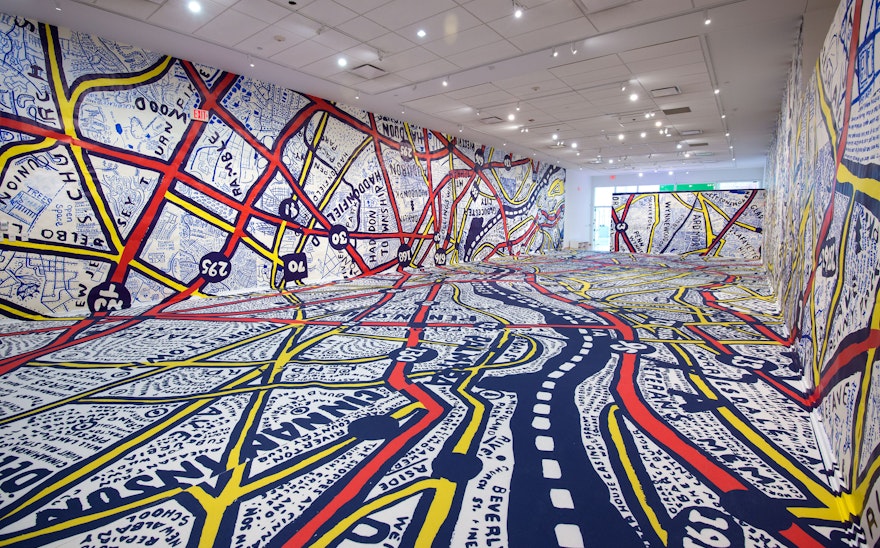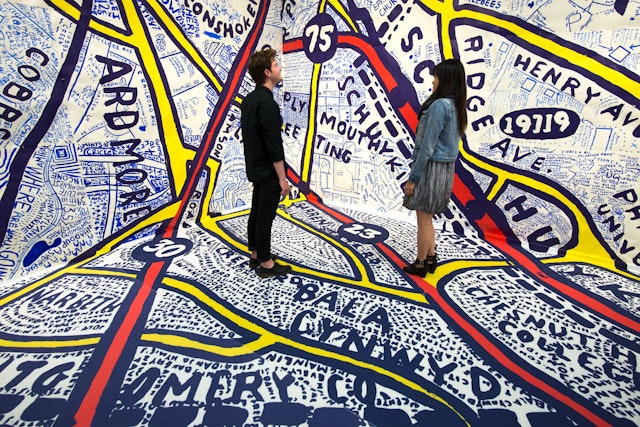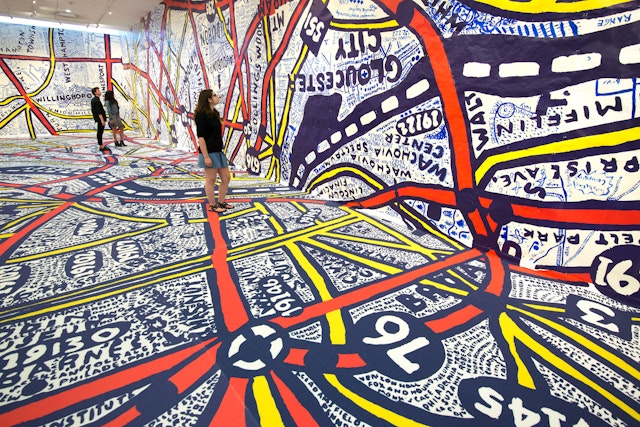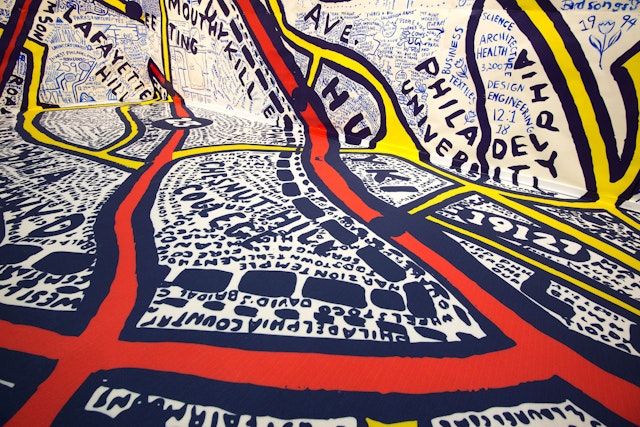



To create a cohesive environment and maintain a certain degree of consistency, the designers put together a set of guidelines for the students to follow that advised them on the scale of their strokes—highway brush strokes are wider than street strokes—and lettering.



In her typographic map paintings, Pentagram’s Paula Scher explores ideas of location and individual ways of seeing the world. Now, working in collaboration with students at her alma mater, the Tyler School of Art, Scher has expanded this unique point of view to an immersive environment. Philadelphia Explained is a large-scale installation that details the city and its surrounding areas in a hand-painted map created by Scher and 154 participants that covers the walls and floor of Temple Contemporary, the school's 2,100 square-foot gallery.
Scher was invited to create the installation as part of Tyler’s Distinguished Alumni Mentorship Program. Sponsored by the Office of the Dean of the Tyler School of Art, the program is designed to foster continuing relationships between Tyler alumni who are established in their careers and recent graduates and students. Scher selected as her mentee Keith Hartwig, a 2011 graduate from Tyler’s Architecture department. Hartwig was chosen because he has an interest in the subject matter and was capable of organizing the installation, working with 133 current Tyler students. He has an exhibition in an adjoining space that looks at the intertwining lives of three Philadelphians in seven domed panoramic images.
A personal reaction to information overload, Scher’s map paintings are obsessive and more than a little opinionated, recreating places around the world in multi-layered, hand-rendered typography that identifies locations and landmarks and at the same time provides social commentary. In Philadelphia Explained, Scher asked students to join her in graphically describing the city they know and love. The participants were each given a portion of the map to complete, adding their own level of detail to Scher’s larger graphic outline. The result is a one-of-a-kind portrait of Philly that swarms with individual observations; it may not be geographically accurate, but residents will find themselves in it. For everyone else, it’s like stepping into a trippy typographic vision that gives “street art” a new meaning.
The largest of Scher’s paintings are typically about 8 by 10 feet. To create the more expansive environment of Philadelphia Explained, Scher and her team at Pentagram had to go through several stages of process. Pentagram previously developed a mural for Queens Metropolitan Campus in New York that transferred one of Scher's paintings to a dimensional environment. For that installation, a sign painter enlarged the map on a series of panels that covered and folded around the surfaces of two atriums in the school.
Philadelphia Explained was a little more complicated. Scher first created a 40 ½” by 60” (approximately 3 ½’ by 5’) black-and-white painting of the area. This map was photographed and vectorized into a graphic image. Scher selected major roads and streets to be digitally colored red and yellow; the Delaware and Schuylkill Rivers were colored blue. She then gave the file to Hartwig, who used three-dimensional modeling to figure out how the graphic would wrap around the walls and floor of the gallery. Hartwig segmented the map into 258 panels that would be given back to Scher and the students for a further level of hand-drawn detail.
Scher’s portions of the map comprised the floor (104 panels), while the remaining 154 panels were completed by students. There were actually more panels than student participants, so 21 Pentagrammers—members of Scher’s team and other staffers—jumped into the mix to finish the balance. Each panel was approximately 56" by 42" and was printed with a portion of Scher’s original map. Participants painted in their details with blue and white acrylic paint.
To create a cohesive environment and maintain a certain degree of consistency, the designers put together a set of guidelines for the students to follow that advised them on the scale of their strokes—highway brush strokes are wider than street strokes—and lettering. The participants were encouraged to use Google Maps to identify the landmarks and street-level detail of their area.
For the rug, Scher completed a second painting that was 56” by 150 1/3” (approximately 4 2/3' by 13') and scaled up six times to almost the full size of the room (75’ by 28’). The painting was printed on a carpet—actually three long strips—and installed on the gallery floor. To create a seamless image, the small gaps between the walls and floor were color matched and filled in with acrylic paint.
Scher says the approach can be used to imaginatively—and inexpensively—bring virtually any space to life with environmental graphics. “I can see it used in schools and community centers,” she says. “Students love to participate in creating something that reflects their world.”
Scher and her team would like to thank Blick Art Materials, Mega Media Concepts, and Quaker Chroma Imaging for their generous donation of materials and processes that allowed the exhibition to come together. At Temple Contemporary, Tyler School of Art, the team would like to thank Robert Blackson, director of exhibitions and public programs; Adam Blumberg, exhibitions technician; and Sarah Biemiller, assistant director.
Participants: Haley Adair, Audrey Agnew, Jamie Alloy, Rebecca Alvarez, David Antell, Charles Attisano, Sara Bahowski, Claire Banks, Ellyse Bendillo, Alexander Bezanek, Caitlin Bias, Dani Birnbohm, Simon Blockley, Eliza Botton, Sabrina Brittain, Elizaveta Buzytsky, Tracey Cameron, Zoe Capcara, Kaela Carducci, Marisa Cariala, Cassie Chalfant, Elle Chung, Jeff Close, Timothy Cohan, Rebecca Conrad, Georgiana Constantineson, Ann Crabb, Scott Craft, Melissa Cronk, Korina Dabundo, Giselle Davila, Brooke Davis, Myra DiNicola, Emily Dodson, Russell Edling, Sean Ellmore, Shane Ennis, Christine Fajardo, Ally Farnsworth, Will Farr, Anne Ferril, Anari Fleming, Brandy Fortune, Greg Franyipani, Lucia Garzon, Kat Gilbert, Courtney Gooch, Zachary Goyda, Neil Grewal, Kerry Griner, Sen Gu, Stephanie Haller, Rebecca Hatala, Sydney Hibshman, Kyra Hierl, Kerry Hohenstein, Roxy Hua, Ksenia Hypes, Addison Ingraham, Imani Jackson, Christian Jacques, Moise Jamba, Patrick Johnson, Zach Johnson-Medland, Matia Jones, Celeste Joyce, Kimmy Juhas, Gina Kay, Zeresh Khan, Hanyun Kim, Julia Knight, Irina Koryagina, Tess Kuracina, Nichole Lahney, Stephanie Land, Katherine Larsen, Andi Leibowitz, Shea Rebecca Lohss, Elizabeth Lubitsky, Katey Mangels, Craig Mangum, James Margotta, Gabriel Massalley, Andrew Mazer, Tina McBroom, Connor Sean McCabe, Rebecca McCloskey, Abby McGeehan, Sienna McGinnis, Sarah McKeen, Madeleine McMichael, Gillian Mead, Azadeh Mejmarian, Jordan Mizrani, Sean Moss, Ilana Napoli, Michael Nease, Thanh Nguyen, Kehmari Norman, Henry Nuhn, Saumon Oboudiyat, Karin Palter, Tanner Panetta, Deva Pardue, Rachel Peuaman, Mariya Pilipenko, Chloe Pinero, Isaac Potter, Xinyae Qian, Cassandra Reffner, Alex Rehoric, Laura Revelt, Margie Richezza, Ben Rodrigo, Matthew Rowe, Emily Ryan, Talia Saltzman, Matthew Scaramozzino, Mary Schertz, TaLeah Schoetmer, Isabella Schubert-Jones, Julianna Scotese, Clara Scruggs, Vivienne Shao, Ian Shelton, Emma Shimberg, Andrea Shiner, Rory Simms, Ryan Smith, Alex Spassef, Jordan Speichen, Courtney Spencer, Neil Spencer, Veronica Stabley, Lea Stephenson, Franziska Stetter, Christian Stewart, Hannah Strayline, Blaise Sudano, Laura Tabbut, Kristen Taylor, Igli Toshi, Jenna Wandishin, Ruaxue Wang, Joe Wanovich, Elliot Wattenbager, Lucy Weigard, Elliot Wilson, Sam Winefield.
Sector
- Education
- Arts & Culture
Discipline
- Exhibitions
Office
- New York
